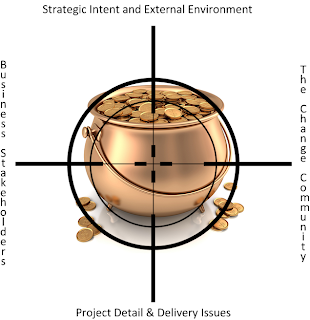As an advocate of smarter change, a curious observer of life and its challenges and a generous sharer of interesting thoughts and ideas, this is an eclectic collection of posts that I hope will entertain, inform or simply stimulate your thinking. I am available as a change leader and catalyst, writer, mentor, coach, speaker ........... and sometime stand up comedian.
Thursday, 18 October 2012
In the PMO crosshairs
I was talking earlier today about the shape of modern (Change) portfolio management and the path to success.
In "project world" there is a well documented model of a triangle of time, cost and quality, being the three dimensions that need to be assessed and balanced by any project manager seeking to deliver a successful project. We all know it is never quite as simple as that, but to have an easily understood model is very useful.
In establishing a Programme Management Office I have previously used a two-by-two Boston Consulting Group style matrix to facilitate discussion. This put control along one axis and influence along the other giving four zones; Administrator (low control & low influence), Controller (high control, low influence), Partner (low control, high influence) and Director (high control, high influence). This proved useful in establishing a perception of where a PMO is and where it wants (or is wanted) to be. It can be a powerful filter for building the list of functions required in a PMO and those that are outside the brief.
This morning I did not use that model, but instead drew a verbal picture of the crosshairs recreated above as illustration of the balance a successful Programme Director/Manager/Office needs to negotiate.
Across the horizontal are the stakeholders with the business owners and interested parties to the left and the change community (project and programme managers, planners and analysts, etc) to the right. Unless you deal with and appeal to both, you will struggle. At different times you will challenge each and at others you will defend them. Choosing the right time and the right battles is critical and not always easy as others try and use you as a tool for their own ends. Having courage, strength, understanding and judgement are not optional.
Down the vertical (and by the way we could change the asxes, there is not reason why one is vertical and the other not) is the spectrum of insight required. It is essential that a Programme function keeps a weather eye on and understand the strategic intent and challenges of the the organisation it serves, but at the same time it has to know enough of the detail plans and issues to assess, inform and support. The last thing it needs or wants to do is micromanage the delivery teams. Instead it should be an enabler.
Finding the balance of enough detail and not too much takes time, trust, experience and an instinct for what is important. As portfolio manager, what I need today may well be different from what I needed last week, and tomorrow may be different again. The trust relationships and understanding I build with the delivery teams is critical is they are not to see me as whimsical and a burden.
I think I will leave this post right here, but may well return in future. I would certainly be interested to hear anyone else's thoughts?
Subscribe to:
Post Comments (Atom)

No comments:
Post a Comment
If something I have said has made you think, angry or simply feel confused, please to leave comment and let me know.